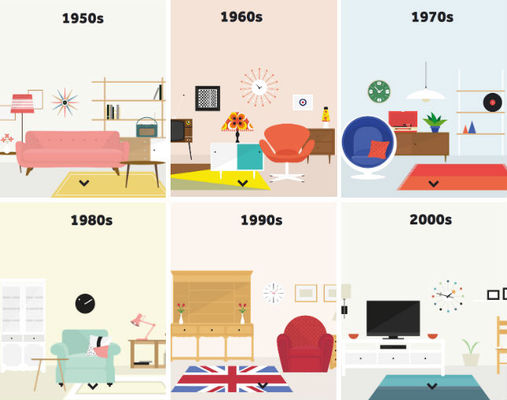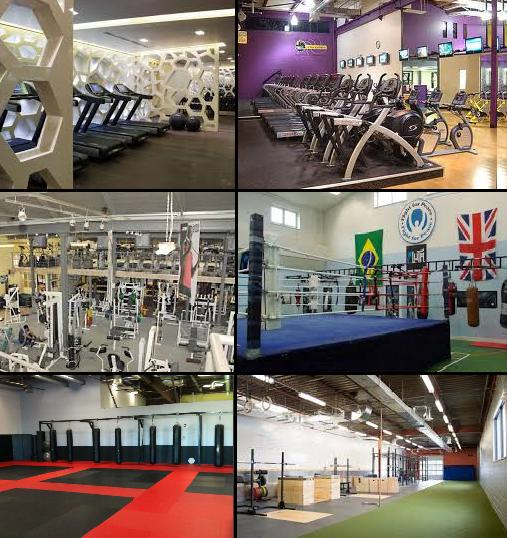Management guru Peter Drucker advised "the best way to predict your future was to create it"
In contrast, embracing the creative template of a trend is an unsustainable formula for long term scaling of a business.
The accompanying image illustrates a simplified identification of six design trends that define the fitness landscape, an expose if you will, of the creative realm of gym design. (In an effort to keep this to a short read I have not included the micro brands, macro brands and other manifestations of fitness facility design). To note, yes, each design is nice, I'm not denigrating any brand here. I'm providing insight into the trending aspects of gym design.
Those who enter into these fitness segments adopt wholesale the identifying aesthetics and characteristics of that segment, simply that is, following that segment Trend. It's formulaic. Some might change colors, shift programing or specify different equipment. Others might embrace some elemental architectural features or different amenities or graphics, but all this, more or less, could be described as better sameness.
Regardless, adopting a trend undermines a developer's ability to stand out and dominate his or her market. It specifically becomes challenging, more so, when another player enters the same market embracing similar aesthetics at the same membership price point.
1. The Luxury Gym or Boutique Design. Boutique Design, in my opinion, is the single greatest threat to the future of fitness facility design. The aesthetic is an exhausted cliché adopted across all of commerce and is considered by the design intelligentsia to be sophisticated, stylish and cool. This trend is embraced in virtually all manner of enterprise including but not limited to hotels, restaurants, lounges, spas, residences, retail, offices and now gyms. I will go into further detail in a future post. The greatest disadvantage for a gym brand in employing this aesthetic is that it telegraphs nothing about fitness and everything about the trend.
2. The Big Box Gym. The chain gym is a brilliant business model that is here to stay. The success of the model has generated a legion of like "modelers" and the goal is to be the first one in and occupy real estate. The aesthetic is executed (in varying degrees of success) in the use of a two color paint scheme, an edgy slogan, a logo and color coordinated fitness equipment. Perhaps the greatest challenge for this model is the slugfest for the target demographic when like brands compete in the same market at nearly identical price points.
3. The Muscle Gyms. The Muscle Gyms spawned the current day fitness industry and the aesthetic is rooted in the hard no nonsense clubs of the 80's, think Pumping Iron. This style is typically a sea of fitness equipment in large open spaces illuminated by HID (High Intensity Discharge) or fluorescent lighting (another gym design faux pas), walls adorned with images of iconic bodybuilders, and the drone of the juice bar blender. These are blue collar gyms loved and revered by those who train hard and a place I personally call home.
4. The Boxing Gym. Boxing Gyms might fall into a niche or micro category but the model appears to have more of a global following. These gyms are simply executed with a boxing ring, industrial lighting, exposed superstructure and (at times) juvenile color schemes. I believe these gyms have a lot of room for growth here in the States, especially if they "theater-ed up" their aesthetics.
5. The MMA Gym. The MMA Gyms appear to be rapidly expanding in their market segment and seem to be an organic offshoot of the Boxing Gym genre. Red and black paint schemes are the colors of choice for these brands though I have yet to find where that is written in the gym design bible. MMA Gyms are invested more in design beyond their Boxing Gym predecessors in the use of geometry and graphics. I will venture to say their colors would pop more, and their design would be more appealing, if they experimented with different Kelvin temperatures in their lighting design and diversified their red and black color schemes.
6. The Crossfit Gym. The Crossfit Brand has taken the US by storm and appears to posses unbridled momentum. The highlight of this aesthetic is the collection of perceived junk yard scrap that define the equipment such as tires, chains, plywood boxes and steel rigging. Industrial and commercial warehouses, void of little to no design, provide the environment. I find it amazing that this fast paced and highly successful phenomena, that is growing across all borders, continues to adopt the underfunded aesthetics of its origin.
Academically we could ask base questions. Is there an advantage in following a design trend? If so, where and by what measure (other than revenue) would a brand find an ROI for such effort? Polemically one could counter. Does following a design trend provide a gym brand with indicators be they social, fiduciary or other, that undermine a brand identity platform?
In summary....I'm leveling the playing field on a subject that gets little press. Hopefully it will result in helping developer's to be better informed on the subject when making investment decisions for new or existing gym models.
Learn more at: www.fitnesscenterdesign.com
Cuoco Black is a design academic, interior designer, entrepreneur and natural bodybuilder. He is a former faculty member and holds a BFA with Distinction and a Professional Design Diploma from the New York School of Interior Design ranked 4th in the World for superior interior design curriculum's by US News and World Report.



















 RSS Feed
RSS Feed
